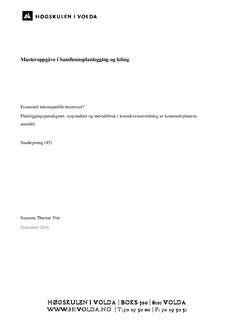| dc.contributor.author | Vist, Susanne Therese | |
| dc.coverage.spatial | Norway, Skedsmo kommune | nb_NO |
| dc.date.accessioned | 2017-04-18T13:38:13Z | |
| dc.date.available | 2017-04-18T13:38:13Z | |
| dc.date.issued | 2016 | |
| dc.identifier.uri | http://hdl.handle.net/11250/2437642 | |
| dc.description.abstract | Summary
The subject of this paper is methodology in impact assessment (IA) of spatial planning, limited to IA of coordinated residential, area and transport plans in municipal spatial planning, limited to the area-plan. The thesis is: " Methodology in impact assessment of spatial planning, explained with Alexander's theory of planning-paradigms and rationality". This stance in philosophy of science, is derived from critical rationalism and hermeneutics. The most important foundation of my thesis is Ernest Alexanders article from 2000: "Rationality revisited: Planning Paradigms in a Post-Postmodernist Perspective", which describes four planning paradigms (Classic Rational Planning, Communicative Practice, Coordinative Planning and Planning as Frame Setting), and four categories of rationality. The basis for this paper is the impact assessment regulation § 7, which states that IA is to be completed by means of reputable methodology, by competent practitioners. There is no unified understanding of what reputable methodology is, or a unified definition of who competent practitioners are. This opens up to an uncertainty in how this part of the regulation is to be interpreted and executed. Research strategy is a qualitative methodology case study approach with two cases: Area-plan 2014-2025 for Drammen municipality and Area-plan 2015-2026 for Skedsmo municipality. I use open source public records for this paper. This method does not give room for a generalized approach to the findings in the case study. Main findings is that elements from all four planning paradigms can be found in governmental guidelines for coordinated housing, area and transport spatial planning, and in both cases. Another finding is that the Framing paradigm is more present than expected in the governmental guidelines. The case studies show that there are several different methods used for IA of coordinated living, area and transport plans in municipal spatial planning, there are a variation of which factors that is assessed and the presentation of the IA also varies. The paradigm most visible in the planning process of the various plan elements is also the one most visible in the IA and the chosen IA methodology coordinated living, area and transport plans in municipal spatial planning, limited to the area-plan. There is a possibility that findings from this case study can contribute to, and be used in the assessment of what is perceived as reputable methodology and competent practitioners in the spatial planning impact assessment. | nb_NO |
| dc.description.abstract | Sammendrag
Tema i oppgaven er metodebruk i konsekvensutredning (KU) av arealplaner, avgrenset til KU av samordnet bolig-, areal- og transportplanlegging for kommuneplanens arealdel (arealdelen). Problemstillingen er: ”Metodebruk i konsekvensutredning av kommuneplanens arealdel, forklart ved bruk av Alexanders teori om planleggingsparadigmer og rasjonalitet”. Den vitenskapsteoretiske posisjonen tar utgangspunkt i positivismekritikk, og hermeneutikk. Det viktigste teorigrunnlaget er Ernest Alexanders artikkel fra 2000: ”Rationality Revisited: Planning Paradigms in a Post-Postmodernist Perspective”, om fire planleggingsparadigmer (klassisk rasjonell, kommunikativ, koordinerende, og planlegging som frame-setting) og fire ulike former for rasjonalitet. Bakgrunnen for oppgaven, er konsekvensutredningsforskriftens § 7, som sier at KU skal utføres etter anerkjent metodikk, av personer med relevant faglig kompetanse. Det foreligger ingen omforent forståelse av hva som er anerkjent metodikk, eller hvilke personer som har relevant faglig kompetanse, noe som åpner for usikkerhet om hvordan bestemmelsen skal tolkes og praktiseres. Forskningsstrategien er kvalitativ, med casestudie som består av to case; arealdelen 2014-2025 for Drammen kommune, og arealdelen 2015 – 2026 for Skedsmo kommune. Kildene er offentlige dokumenter. Forskningsdesignet gir ikke grunnlag for å generalisere fra casestudien. Hovedfunn er at trekk fra alle fire planleggingsparadigmer kan identifiseres i statlige planretningslinjer for samordnet bolig-, areal- og transportplanlegging, og i de to casene. Et annet funn, er at framing er mer fremtredende enn forventet, i de statlige planretningslinjene. Casestudien viser at det blir brukt ulike metoder for KU av samordnet bolig-, areal- og transportplanlegging, det er ulike fenomener som blir utredet og vurdert i KU, og KU blir fremstilt på forskjellige måter. Det planleggingsparadigmet og den rasjonaliteten som trer tydeligst frem i planprosessen for hver av arealdelene, trer også tydeligst frem i KU, og i metodebruk i KU. Det er en mulighet for at funn fra casestudien kan bidra til læring, og anvendes i vurdering av hva som er anerkjent metode, og hvem som har relevant faglig kompetanse. | nb_NO |
| dc.language.iso | nob | nb_NO |
| dc.publisher | Høgskulen i Volda | nb_NO |
| dc.title | Essensielt inkompatible interesser? Planleggingsparadigmer, rasjonalitet og metodebruk i konsekvensutredning av kommuneplanens arealdel | nb_NO |
| dc.type | Master thesis | nb_NO |
| dc.rights.holder | Author | nb_NO |
| dc.subject.nsi | VDP::Social science: 200::Urbanism and physical planning: 230::Building and regulation planning: 234 | nb_NO |
| dc.source.pagenumber | 166 | nb_NO |
| cristin.fulltext | | |
